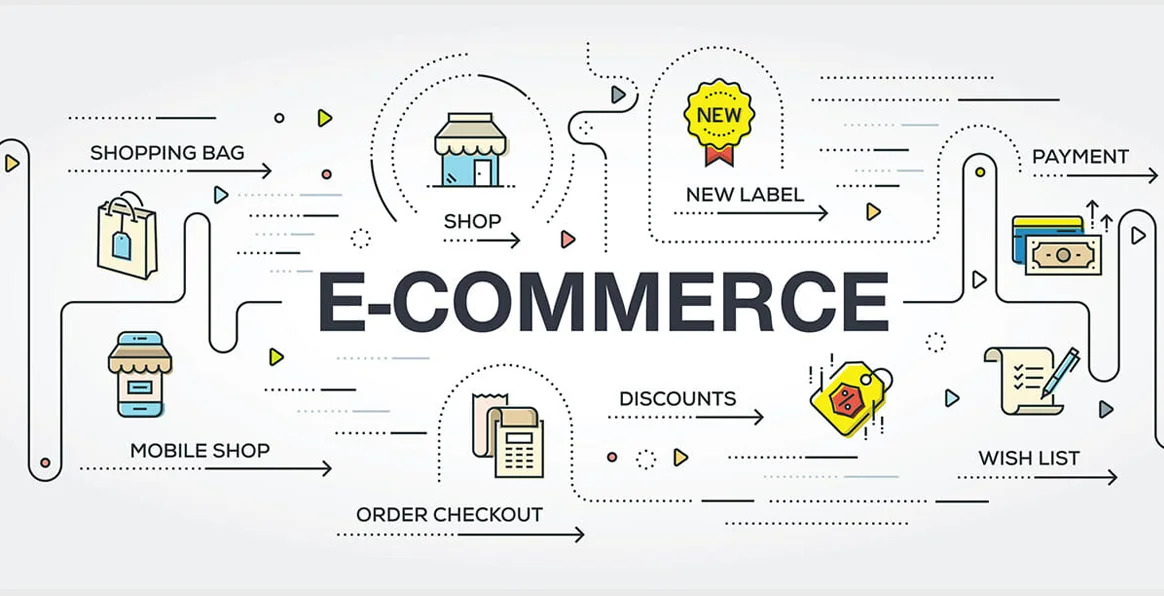
The E-Commerce module provides students with an in-depth understanding of the digital economy and the key components involved in establishing, managing, and growing an online business. This module covers the theories, tools, and strategies required to successfully navigate the online marketplace and create effective e-commerce platforms.
Students will explore digital marketing, online payment systems, web development, customer relationship management (CRM), and security in e-commerce. The module will also focus on business models, such as Business to Consumer (B2C), Business to Business (B2B), and Consumer to Consumer (C2C), highlighting their application in various sectors.
Through practical assignments, case studies, and project work, students will gain hands-on experience in setting up an e-commerce platform, optimizing online user experience, and understanding how to drive traffic, convert sales, and maintain customer loyalty. This module is essential for anyone seeking to enter the rapidly growing field of online business or digital entrepreneurship.
Key Topics Covered:
-
Introduction to E-Commerce – Defining e-commerce and exploring its role in the global economy.
-
E-Commerce Business Models – Understanding B2B, B2C, C2C, and other digital business models.
-
Web Development and Online Store Design – Basics of setting up an online store, user interface (UI), and user experience (UX) principles.
-
Digital Marketing and SEO – Strategies for online advertising, search engine optimization, and social media marketing.
-
Online Payment Systems – Understanding payment gateways, security, and fraud prevention in e-commerce.
-
Customer Relationship Management (CRM) – Building and maintaining strong relationships with customers through data-driven insights and personalized services.
-
E-Commerce Law and Ethics – Navigating legal considerations such as privacy, intellectual property, and consumer protection.
-
Data Analytics for E-Commerce – Using data to analyze sales trends, customer behavior, and business performance.
This module will prepare students to understand the foundational principles of e-commerce, empowering them to successfully develop, manage, and grow online businesses in today's digital-first marketplace.
Course code: MGT 2205
Course credit: 10
Pre-requisites: None
Academic year: 2024-2025
Lecturer: Mr. MUKURU SSESSAZI ALFRED
Tel: 0786679403
Email: eaur.ass.ar@gmail.com
Learning Objectives:- Teacher: Alfred MUKURU SSESSAZI

Summary of Management Information Systems
Definition
Management Information Systems (MIS) are integrated frameworks designed to provide managers with the tools and information needed to make effective decisions and manage operations efficiently. MIS leverages technology to collect, process, and disseminate data, transforming it into valuable information that supports business activities and decision-making processes.
Key Components
- Hardware: Physical technology devices such as computers, servers, and networking equipment that facilitate the functioning of MIS.
- Software: Applications and systems software that process and manage data, including databases, ERP systems, and business applications.
- Data: Raw data that is collected, processed, and converted into meaningful information used for decision-making.
- People: Users and IT professionals who interact with the MIS, from end-users to system administrators.
- Processes: Procedures and policies that govern the collection, processing, and dissemination of information.
Functions of MIS
- Data Collection: Gathering data from various sources, including internal operations and external environments.
- Data Processing: Converting raw data into meaningful information through sorting, aggregating, and analyzing.
- Information Storage: Storing processed information in databases for easy retrieval and future use.
- Information Dissemination: Distributing relevant information to appropriate stakeholders in a timely manner.
Types of MIS
- Transaction Processing Systems (TPS): Manage and record day-to-day business transactions, ensuring data accuracy and integrity.
- Management Reporting Systems (MRS): Generate standard reports summarizing business activities, aiding routine decision-making.
- Decision Support Systems (DSS): Provide tools for analyzing data and making complex decisions, often involving simulations and what-if scenarios.
- Executive Information Systems (EIS): Offer top executives easy access to key internal and external data, often through dashboards and data visualization tools.
Benefits of MIS
- Improved Decision-Making: Access to timely and accurate information enhances the quality of decisions.
- Increased Efficiency: Automation of routine tasks reduces operational costs and time.
- Enhanced Communication: Facilitates better communication and information flow within the organization.
- Data Management: Centralized data storage ensures consistency, reduces redundancy, and improves data security.
Challenges of MIS
- Cost: High initial investment in hardware, software, and training.
- Complexity: Managing and integrating various systems and data sources can be complex.
- Security: Protecting sensitive information from unauthorized access and breaches.
- User Resistance: Resistance to change from employees who are accustomed to old systems or processes.
Conclusion
Management Information Systems play a critical role in modern organizations by providing essential information that supports strategic, tactical, and operational decision-making. By integrating technology, people, and processes, MIS enhances organizational efficiency, effectiveness, and competitiveness in a rapidly changing business environment.
- Teacher: Chebet Asumani

Summary of Management Information Systems
Definition
Management Information Systems (MIS) are integrated frameworks designed to provide managers with the tools and information needed to make effective decisions and manage operations efficiently. MIS leverages technology to collect, process, and disseminate data, transforming it into valuable information that supports business activities and decision-making processes.
Key Components
- Hardware: Physical technology devices such as computers, servers, and networking equipment that facilitate the functioning of MIS.
- Software: Applications and systems software that process and manage data, including databases, ERP systems, and business applications.
- Data: Raw data that is collected, processed, and converted into meaningful information used for decision-making.
- People: Users and IT professionals who interact with the MIS, from end-users to system administrators.
- Processes: Procedures and policies that govern the collection, processing, and dissemination of information.
Functions of MIS
- Data Collection: Gathering data from various sources, including internal operations and external environments.
- Data Processing: Converting raw data into meaningful information through sorting, aggregating, and analyzing.
- Information Storage: Storing processed information in databases for easy retrieval and future use.
- Information Dissemination: Distributing relevant information to appropriate stakeholders in a timely manner.
Types of MIS
- Transaction Processing Systems (TPS): Manage and record day-to-day business transactions, ensuring data accuracy and integrity.
- Management Reporting Systems (MRS): Generate standard reports summarizing business activities, aiding routine decision-making.
- Decision Support Systems (DSS): Provide tools for analyzing data and making complex decisions, often involving simulations and what-if scenarios.
- Executive Information Systems (EIS): Offer top executives easy access to key internal and external data, often through dashboards and data visualization tools.
Benefits of MIS
- Improved Decision-Making: Access to timely and accurate information enhances the quality of decisions.
- Increased Efficiency: Automation of routine tasks reduces operational costs and time.
- Enhanced Communication: Facilitates better communication and information flow within the organization.
- Data Management: Centralized data storage ensures consistency, reduces redundancy, and improves data security.
Challenges of MIS
- Cost: High initial investment in hardware, software, and training.
- Complexity: Managing and integrating various systems and data sources can be complex.
- Security: Protecting sensitive information from unauthorized access and breaches.
- User Resistance: Resistance to change from employees who are accustomed to old systems or processes.
Conclusion
Management Information Systems play a critical role in modern organizations by providing essential information that supports strategic, tactical, and operational decision-making. By integrating technology, people, and processes, MIS enhances organizational efficiency, effectiveness, and competitiveness in a rapidly changing business environment.
- Teacher: Chebet Asumani

